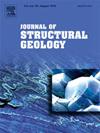Structural and stratigraphic control on fluid flow in the Mt. Conero anticline, Italy: An analog for offshore resource reservoirs in fold-and-thrust belts
IF 2.9
2区 地球科学
Q2 GEOSCIENCES, MULTIDISCIPLINARY
引用次数: 0
Abstract
We investigate the structural control on paleofluid flow in the Mt. Conero anticline, Italy, located in the frontal part of the Apennines fold-and-thrust belt. This anticline can be considered as an exhumed analog for buried anticlines in the Adriatic offshore, currently exploited for hydrocarbons and potential geothermal reservoirs or CO2 storage sites in the future. By integrating field structural analyses, stable and clumped isotope geochemistry of carbonates, and U-Pb geochronology, we demonstrate that the structural evolution of the Mt. Conero anticline in a carbonate-siliciclastic succession is marked by: (1) pre-orogenic normal faulting and veining during foreland flexure, (2) layer-parallel shortening during early contraction, with the development of en-echelon bed-perpendicular conjugate veins and stylolites, (3) syn-folding thrusting and strike-slip faulting, and (4) transtensional faulting during fold exhumation and extensional collapse. Fluid circulation took place in a closed system, predominantly involving formation water, such as marine pore water trapped during diagenesis. Effective sealing by clay-rich formations overlying the fractured, permeable carbonates, coupled with low displacement strike-slip faults and thrusts, prevented the ingress of meteoric fluids and/or the upward migration of deep (hydrothermal) fluids. Limited mixing between formation and meteoric waters in a semi-closed system was observed during fold exhumation and extensional collapse. Our results show that folds in the frontal part of offshore fold-and-thrust belts are likely to retain fluids trapped during diagenesis due to the preservation of sealing layers. This suggests that such anticlines can preserve hydrocarbon reservoirs and are excellent candidates for CO2 storage due to their low leakage potential, offering also good storage capacity for geothermal fluids. These results may represent a benchmark for offshore anticlines in the frontal part of other offshore fold-and-thrust belts, particularly those with carbonate anticlines overlain by clay-rich sealing layers.
意大利Conero山背斜流体流动的构造和地层控制:对褶皱冲断带海上资源储层的模拟
本文研究了位于亚平宁褶皱冲断带前缘的意大利Conero山背斜古流体流动的构造控制。这个背斜可以被认为是亚得里亚海近海埋藏背斜的一个被挖掘出来的模拟物,目前正在开发碳氢化合物和潜在的地热储层或未来的二氧化碳储存场所。综合野外构造分析、碳酸盐岩稳定和块状同位素地球化学、U-Pb年代学等资料,认为Conero山背斜的碳酸—硅屑演替过程具有以下特征:(1)前陆弯曲期的造山前正断裂和脉化作用;(2)收缩早期的层平行缩短作用,形成了成列的垂直层状共轭脉和柱面岩;(3)同褶皱逆冲和走滑断裂作用;(4)褶皱掘出和伸展崩塌期的张拉断裂作用。流体循环发生在一个封闭的系统中,主要涉及地层水,如成岩过程中圈闭的海相孔隙水。裂缝性、渗透性碳酸盐岩上覆的富粘土地层有效封闭,再加上低位移走滑断层和逆冲断层,阻止了大气流体的进入和/或深部(热液)流体的向上运移。在褶皱发掘和伸展崩塌过程中,观测到半封闭系统中地层与大气水的有限混合。研究结果表明,在近海褶皱冲断带前缘褶皱处,由于密封层的保存,可能会保留成岩过程中圈闭的流体。这表明,此类背斜具有保护油气藏的作用,由于其低泄漏潜力,是CO2储存的绝佳候选者,也为地热流体提供了良好的储存能力。这些结果可以为其他海上褶皱冲断带前缘的海上背斜,特别是覆有富粘土封层的碳酸盐岩背斜提供参考。
本文章由计算机程序翻译,如有差异,请以英文原文为准。
求助全文
约1分钟内获得全文
求助全文
来源期刊

Journal of Structural Geology
地学-地球科学综合
CiteScore
6.00
自引率
19.40%
发文量
192
审稿时长
15.7 weeks
期刊介绍:
The Journal of Structural Geology publishes process-oriented investigations about structural geology using appropriate combinations of analog and digital field data, seismic reflection data, satellite-derived data, geometric analysis, kinematic analysis, laboratory experiments, computer visualizations, and analogue or numerical modelling on all scales. Contributions are encouraged to draw perspectives from rheology, rock mechanics, geophysics,metamorphism, sedimentology, petroleum geology, economic geology, geodynamics, planetary geology, tectonics and neotectonics to provide a more powerful understanding of deformation processes and systems. Given the visual nature of the discipline, supplementary materials that portray the data and analysis in 3-D or quasi 3-D manners, including the use of videos, and/or graphical abstracts can significantly strengthen the impact of contributions.
 求助内容:
求助内容: 应助结果提醒方式:
应助结果提醒方式:


